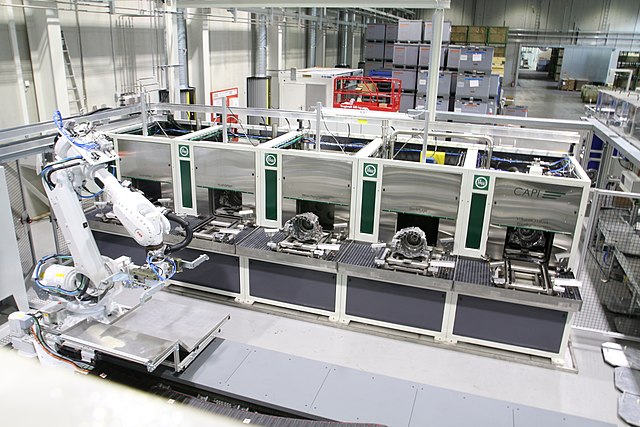- December 18, 2019
- Posted by: David Marshall
- Category: Digital Transformation, Manufacturing

With today’s smart manufacturing technology, artificial intelligence, the Internet of Things, sophisticated measurement technology, and better/deeper analytics, companies that aren’t taking advantage of these advances are almost certainly doomed to fail.
A recent article on SupplyChainBrain.com wondered whether smart factories could revive the productivity of U.S. manufacturing.
Short answer, yes.
Long answer, very much so.
 If you’re looking for a boost in productivity, reduction in labor costs, and reduction in errors and scrap, a more automated approach is ideal for small- to medium-sized manufacturers looking to increase their advantages over overseas factories where human labor is paid only a few dollars per hour, if not per day.
If you’re looking for a boost in productivity, reduction in labor costs, and reduction in errors and scrap, a more automated approach is ideal for small- to medium-sized manufacturers looking to increase their advantages over overseas factories where human labor is paid only a few dollars per hour, if not per day.
They concluded that smart factories could “(result) in a tripling of productivity improvements over the next decade.”
The survey broke companies into three different categories: Trailblazers, companies that quickly implement the latest technology, which make up 18% of the sample; Explorers (55%), who will use new technology; and, Followers, companies who “are waiting for things to be proven out,” make up the last 27%.
In other words, almost a typical bell curve of trailblazers, explorers, and followers.
It’s the last 27% that has me concerned.
This distribution is usually the case for most manufacturers when it comes to new ways of thinking. There’s always a group that waits until the last possible minute to make any changes. They’re unwilling to adapt, hoping the industry will revert, or at least not change so quickly. And as a result, they’re the ones who close down first when the barrier to entry has become too cost-prohibitive.
You’ve heard of the analogy of Henry Ford versus the buggy whip manufacturers? There are always some manufacturers who can’t, or won’t, face the reality that the industry has changed for good, and that they need to adapt or die.
(To be fair, somebody is still making buggy whips.)
But according to the survey, the results clearly show the benefits of upgrading sooner rather than later.
Additional improvements on the factory floor were seen in the form of higher labor productivity (19% for trailblazers and 12% for the other two groups), and production output (18% for trailblazers and 10% for the rest).
Trailblazers further distinguished themselves by devoting more resources to smart technologies — roughly two-thirds of their manufacturing budgets, versus around 30% for explorers and followers.
Smart manufacturing technology is going to have three positive impacts on your operation, even if you would just start slowly transitioning to more automation, as well as start measuring the performance and output on your machines and processes.
- Errors are reduced, if not minimized. An automatic system can operate almost completely error-free, bringing your error and rejection rate down to nearly 0. Look at what your current error rate is, and how much it’s costing you in terms of lost sales, lost raw materials, and the cost of production. Even upgrading one machine to make a part that normally has a high error rate could make a big difference in lost profits.
- Reduced labor costs, but higher salaries. We’re seeing an overall decrease in general manufacturing jobs, but a much higher demand for skilled labor. People with certain skills, like operating a CNC router, 3D printer, or other manufacturing technology are easily earning 6-figure salaries.
- Increase overall productivity without increasing labor. When I rebuilt a fiberglass liner factory, we were able to quadruple our productivity while reducing our head count and total hours worked each day. We cut our error rate to near-zero, which greatly reduced our rejects, and increased our profits into the millions of dollars per year.
Smart manufacturing is a major change in how manufacturing is done. It’s not a fad that will go away, it’s not a trend that you can safely sit out and still expect to remain healthy. If you’re not a Trailblazer or even an Explorer, you should start looking at how you can embrace smart manufacturing technology in small steps.
No one expects Followers to suddenly change their mindset and fully embrace new technology. But taking baby steps and finding small ways to step toward the future will go a long way in keeping up with the Explorers and outpacing/outlasting the Followers who are still waiting until the last possible minute to change.
I’ve been a manufacturing executive, as well as a sales and marketing professional, for a few decades. Now I help companies turn around their own business, including adopting smart manufacturing technology. If you would like more information, please visit my website and connect with me on Twitter, Facebook, or LinkedIn.
Photo credit: Godfrey&Wing (Wikimedia Commons, Creative Commons 4.0)

